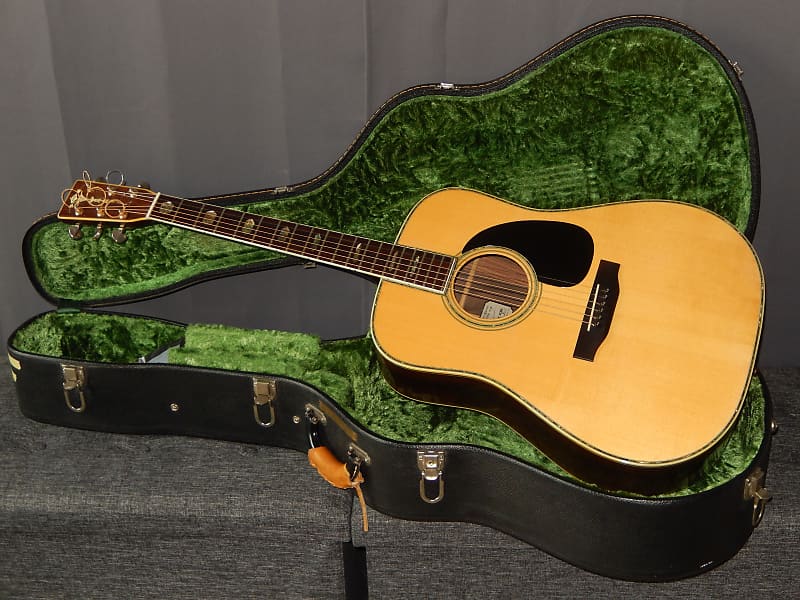

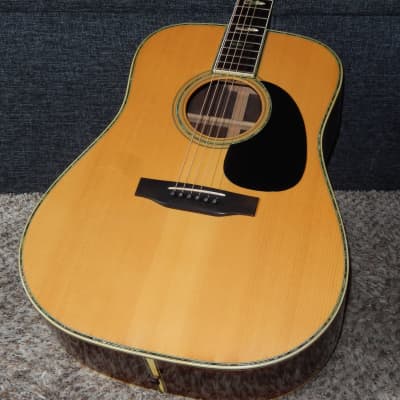
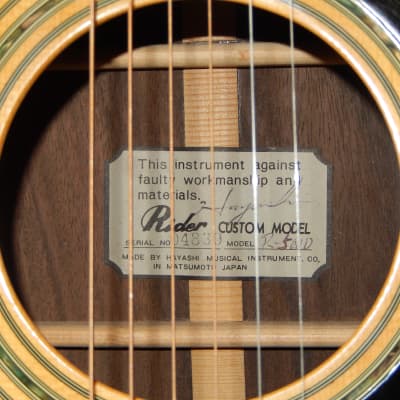
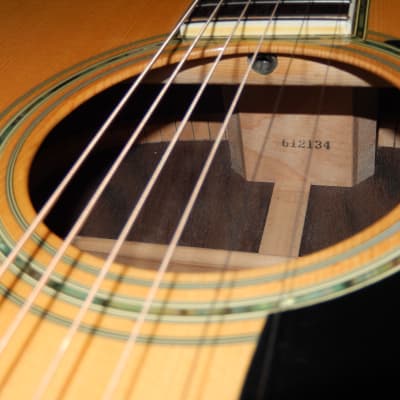
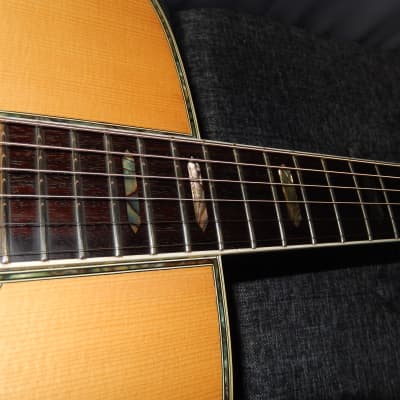
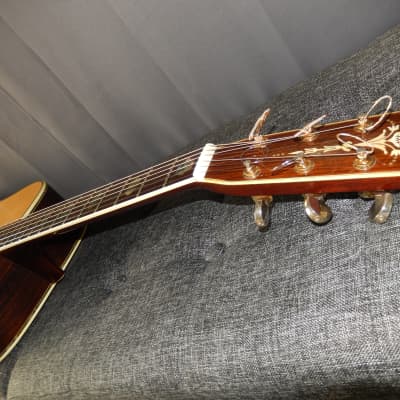
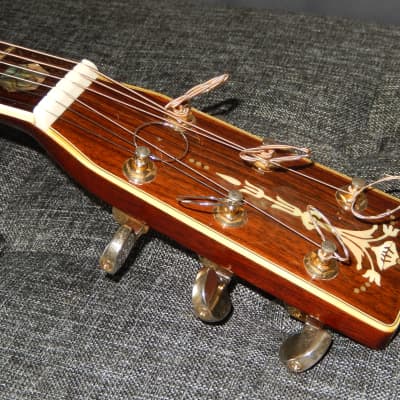
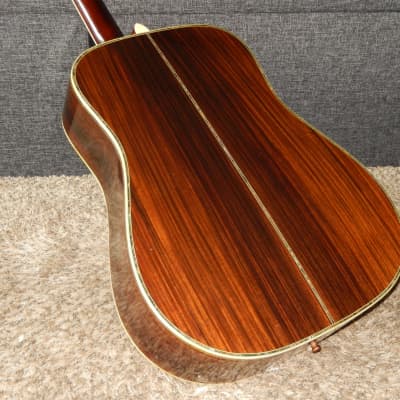
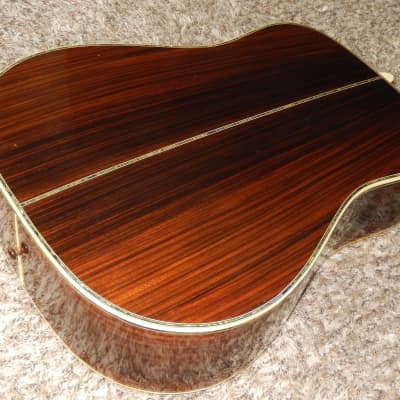
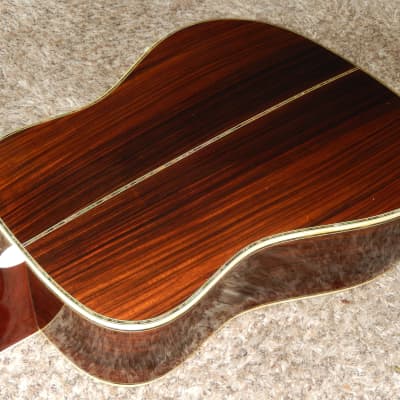
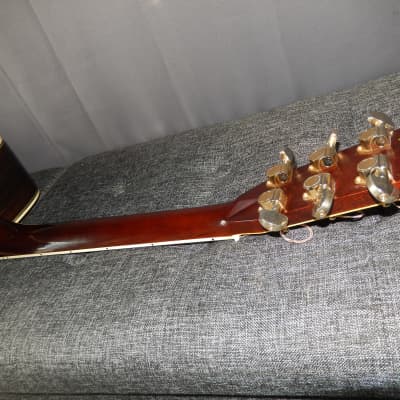
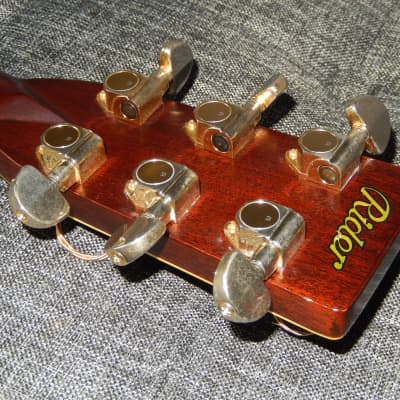
Rider R500D 1976 s.n. 04839
This terrific guitar was made around 1976 made by Hayashi Gakki under personal supervision of Master Luthier Yasuo Momose.
Hayashi Gakki’s luthiers were also making few lines of steel string acoustic guitars ordered by various importers or domestic distributors. One of these lines were C.F Mountain guitars distributed by WESTON Music company. All these lines were supervised by Mr. Momose.
Rider guitars were launched in 1975 and were made only for 3 years, until Mr. Momose left Hayashi Gakki in late 1977 to establish his own (soon to become famous) Headway Guitars workshop.
Headway guitars are made until today and are very highly regarded (and priced) wherever they are distributed. Mr. Momose in Japan has the same high status as Terry Nakamoto (long time head master luthier at Yamaha’s Custom Shop). Soon after you start playing this guitar, you’ll know why Yasuo Momose and his Headway guitars are so highly regarded in Japan, Europe, Australia and Asia. You can read short chapter about Mr. Momose presented below the posting.
Guitar you are looking at, although inspired by Martin blueprints is more of Momose’s own creation. Mr. Momose was a great innovator and his guitars sounded far better that those offered by other Japanese makers of that era.
One of Momose’s innovations were high performance 3 layered “laminates” with maple core. Another innovation was the use of maple inserts in the neck at the neck/body joint. All these innovations greatly enhance transfer of vibrations along the body and neck of the guitar.
Even though R500D was not “the top of the line” model it is a superb instrument that can easily challenge all $5000 guitars sold today in USA. I am sure that all experienced players will agree.
This guitar surely deserves “Grand Concert” title. It is so responsive that you can control its volume and to some extent modulate its tonality. It will sound loud and very rich when you play harder but will sound very lyrical and gentle when you play lighter. All its notes are sparkly and sweetly colorful, and all with their own overtones. Its sustain is so immense that you don’t need to play much to keep it alive. If you decide to strike harder a full chord you almost hear a symphony orchestra. This is one of those “very hard to put down” guitars. It will charm even most demanding listener.
90% of the price (you are about to pay) is for the sound, 10% for the looks and label is free.
This guitar was priced 50 000 yen in 1976. Yet it can easily beat many other Japanese guitars of that era priced 100 000 yen. The same class (and with similar looks) model HD208 made by Headway in 1978 was already priced 80 000 yen.
If you wanted to purchase hand made in Japan brand new guitar with the same construction and looks you could possibly find one for $3500. However, if you wanted this guitar to be made from 40+ years old woods and sound like vintage one, you would need to spend at least $4500.
This is not very difficult to find out what are current prices for acoustic guitars hand made in Japan.
This guitar comes with few imperfections. There are few very minor marks on the top, back and sides. There are brownish discolorations along small sections of originally creamy white bindings. Original tuning keys have lost some of their original luster.
The only “serious” imperfection is that one can feel the sections of the very edge of the plastic center wedge joining side plates (where the endpin is mounted). This is quite common occurrence on vintage guitars, caused by different response to temperature and moisture fluctuations between wood and plastic. As result finish between the two materials cracks exposing the edge of either one, while all the parts are still firmly bound together. Therefore, such occurrence can be considered an imperfection but certainly not a defect.
Despite all its imperfections, overall condition of this guitar can be described as “excellent for its age”.
Very importantly its neck is straight, fingerboard and levelled frets in excellent shape. With its quite low action it plays super easy.
Specifications:
Top: Solid Spruce/ Martin style bracing with non-scalloped braces/ thin coat of lacquer
Back & Sides: Brazilian Rosewood with Maple core “laminates”/ urethane
Fingerboard: Ebonized Rosewood
Neck: Mahogany
Scale 645 mm
Width at Nut: 43 mm
Its action is set to 2.30 mm under E6 and 1.80 mm under E1 with still some extra room on the saddle.
My posted for sale guitars are stored in climate-controlled vault already packed into shipping boxes, with loosen strings. Because the strings are loosened, they don’t pull the neck or soundboard, and the neck may relax (straighten more) and the soundboard flatten a bit, which may result with the string action being lower than my it was with my original settings and lead to buzzes and/or dead notes after guitar arrives to you. Such a change in neck curvature can also happen just because of vibrations during the shipment and/or temperature fluctuations. Therefore, you must be ready to make final action adjustment yourself and or have it done by professional. All that really needs to be done is the simple neck adjustment by using the truss rod (turning the truss rod counterclockwise will relief the neck and strings will move away from the frets).
THAT IS WHY TRUSS RODS ARE INSTALLED IN THE NECKS OF ACOUSTIC GUITARS!!!
This guitar will be shipped in used original hard shell case in still very good condition.
Yasuo Momose and Headway Guitars Story
Before starting his own workshop, Mr. Momose was already famous for making very fine acoustic guitars at Hayashi Gakki. Being helped by his business partner Mr. Yatsuka (current CEO of Deviser company, a distributor of Headway guitars) Momose started making Headway guitars in 1977. His guitars rather quickly won great popularity not only in Japan, but also many other countries. Although their construction was based on Martin blueprints, these guitars had their own unique characteristics and soon became sensation. It seemed that Headway guitars were on the straight path to be highly regarded all over the world. Sadly, in 1983 their workshop and warehouse, were destroyed by 2 fires. Mr. Momose lost most of his own design tools, forms, jigs and machinery, as well as lots of materials that were waiting for production. After this huge loss, company was unable to restart production of acoustic guitars. Instead they concentrated on making electric guitars, in 1980s branded as Riverhead and 1990s as Bacchus. They were also making many OEM electric guitars for other leading Japanese brands. However, during all these years guitar players kept asking about Headway acoustics. Thanks to contacts with guitar enthusiasts running acoustic guitar forums, Mr. Momose knew that because of their greatness and limited numbers, his Headway guitars became highly sought by players and collectors, even gaining in value. Knowing that and having recovered financially, in 1999 company was able to re-start production of their steel string acoustics. As of today, Headway acoustics are distributed all over Asia, in Australia and Europe. You can easily find their website, see their models and prices.
The key to understand value of vintage Japanese guitars is to acknowledge galloping price inflation (devaluation of Japanese yen) during 1960s & 1970s. This inflation slowed down in 1980s.
During 1960s and most of 1970s model numbers of Japanese guitars were strictly interconnected with their prices in Japanese yen. By early 1980s and during following decades model numbers were no longer strictly associated with their prices. Some Japanese guitar makers introduced model names instead of model numbers. Others were still using model numbers with addition of letters and/or other symbols.
It is important to understand that two Yamaha GC10 guitars made 10 years apart are two instruments of totally different class. The same applies to any other Japanese maker/brand.
Any guitar priced 100 000 yen in 1970 (labelled usually as No10) would be priced 200 000 yen in 1975 (relabeled to No20 or 2000), 300 000 yen in 1977 (labelled as No3, No30 or 3000). Starting in 1977 Masaru Kohno introduced his new models No40 priced 400 000 yen and No50 priced 500 000 yen. By 1984 Kohno started using model names instead numbers and was raising their prices as he was pleased. The very top model 50 became model “Special”, and a decade later it became model “Maestro”. Naturally, all other Japanese guitar makers were doing the same pricing (labelling) upgrades.
Knowing all of that, you can bet on that Masaru Kohno No50 made in 1982 is practically the same grade instrument as Kohno No20 made in 1972, or Kohno no 30 made in 1975.
In 1970 the lowest Ryoji Matsuoka (all laminates) model was 10, followed by (solid top) models 15, 20, 25, 30, 40, 50, 60, 80 and (all solid woods) models 100 and 150. Models 60 and 80 were made with non-solid figured Brazilian Rosewood (double) b/s and top model 150 was the only one made with solid figured Brazilian Rosewood b/s.
In 1980 the lowest Matsuoka model was (all laminates) 20, followed by (solid top) models 30,40,50, 60 and all solid woods models 80,100,150 and 200. By 1990 the lowest Matsuoka model was M40 and the highest was M300. By 2010 the lowest Matsuoka model was M50 and the top model was M270.
You can bet that Ryoji Matsuoka model 50 from 1980 is of the same grade as model M100 from 2000, model 100 from 1980 is of the same grade as model M150 from 2000, model 150 from 1980 is of the same grade as M200 from 2000 and model 200 from 1980 is of the same grade as model M300 from 2000.
It is important to mention that if modern era luthiers are using 40+ years old woods to make an “all solid” wood classical guitar, its price is minimum $8000.
All vintage guitars made with Brazilian Rosewood are especially precious, including those made straight grain varieties and those with non-solid b/s.
Because response and tonal properties of Spruce soundboards are improving over time, long seasoned Spruces are far more precious than long seasoned Cedars.
It is not that very difficult to find out what are current prices of such guitars made by world’s leading luthiers.
Reverb Buyer Protection
Reverb has your back if your item is lost, damaged, or doesn't match its description. Simply report any issues within 7 days and we'll help you get a full refund.Learn more about Reverb Buyer Protection.
| Listed | 2 years ago |
| Condition | Excellent (Used) Excellent items are almost entirely free from blemishes and other visual defects and have been played or used with the utmost care.Learn more |
| Brand | |
| Model |
|
| Finish |
|
| Categories | |
| Year |
|
| Made In |
|
| Body Shape |
|
